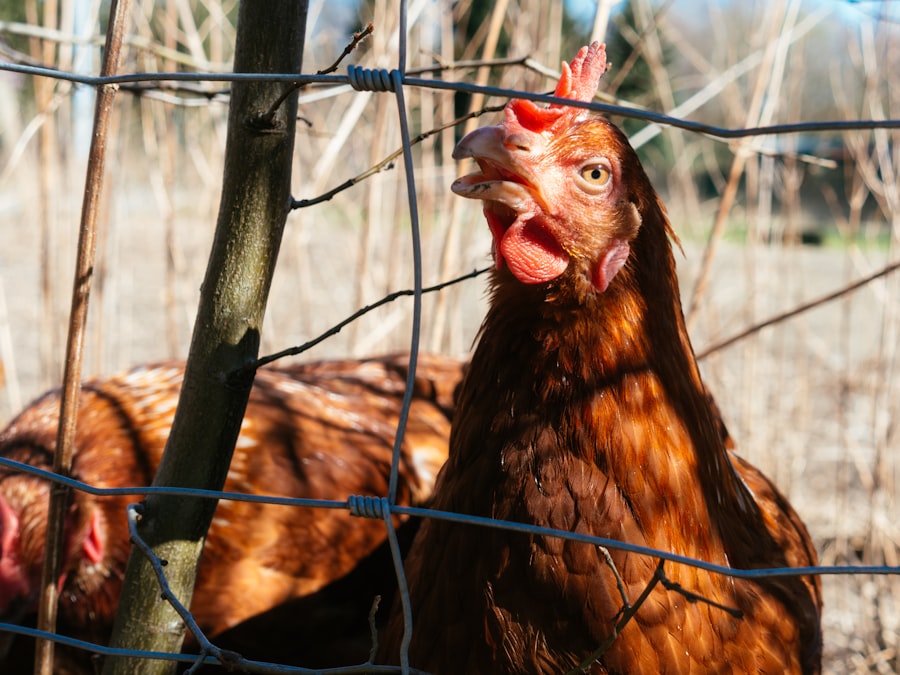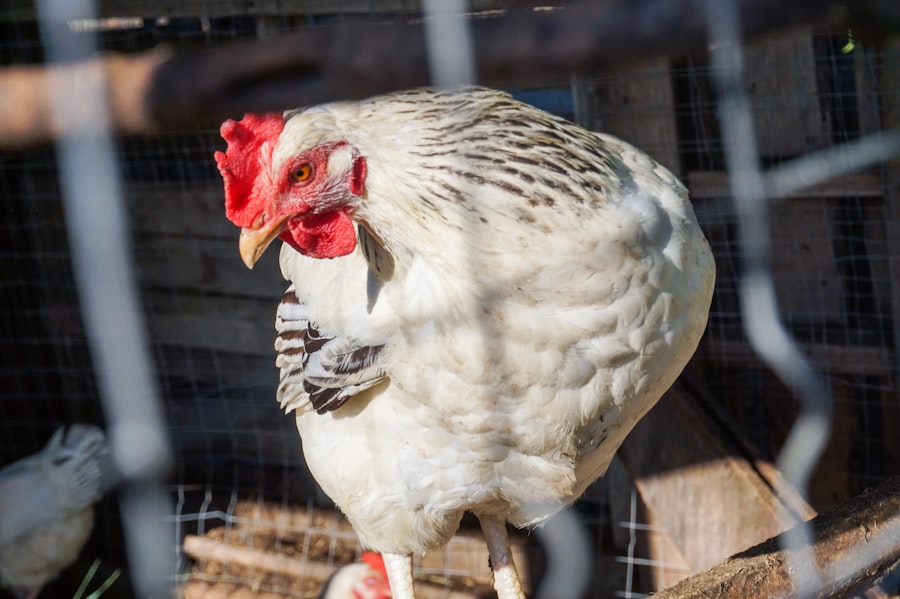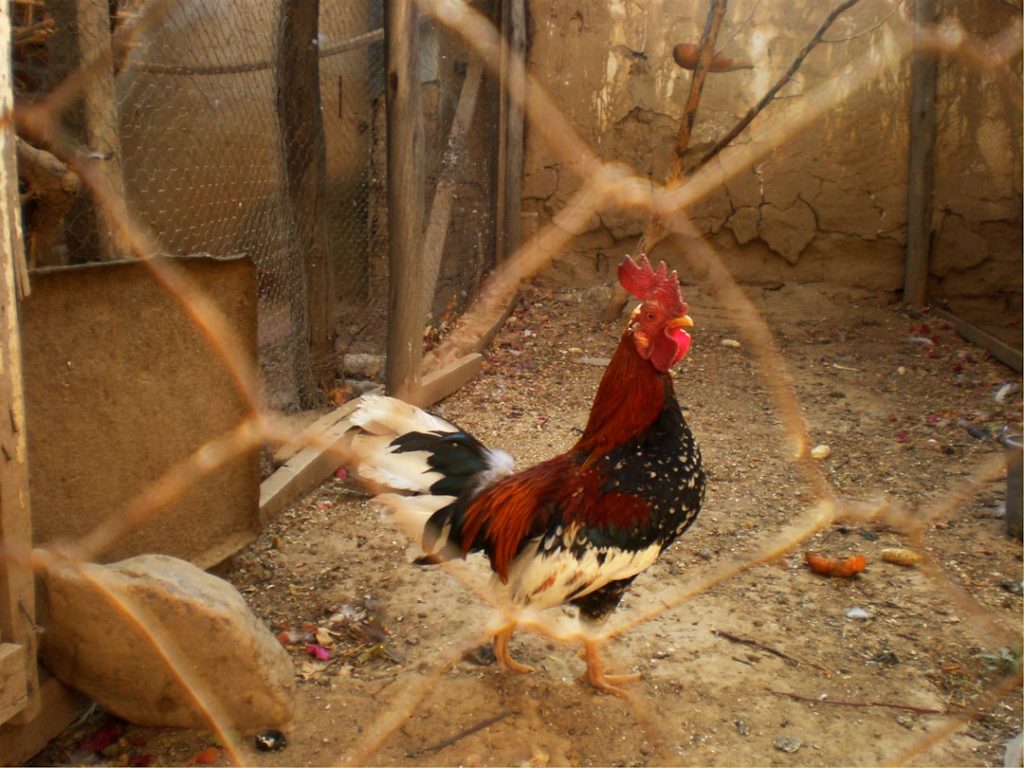Chickens are naturally curious and inquisitive animals with a strong instinct to scratch and forage for food. This behavior is essential for their well-being, as it allows them to find insects, seeds, and other small organisms that comprise a significant portion of their diet. Chickens also exhibit a strong sense of hierarchy within their flock, often following the lead of more dominant birds.
Understanding these natural behaviors is crucial when attempting to deter chickens from certain areas, as it enables working with their instincts rather than against them. Chickens are highly social animals that prefer the company of other chickens. As a result, they tend to congregate in areas where they feel safe and comfortable, such as around their coop or in locations with ample cover.
By comprehending these social dynamics, one can better predict where chickens are likely to gather and take appropriate measures to deter them from these areas. Overall, understanding chicken behavior is essential for effectively managing their movements and activities on a property.
Table of Contents
- 1 Creating physical barriers
- 2 Using natural deterrents
- 3 Implementing visual deterrents
- 4 Providing alternative areas for scratching and foraging
- 5 Training chickens with positive reinforcement
- 6 Seeking professional advice
- 7 FAQs
- 7.1 What are some effective methods for keeping chickens out of flower beds?
- 7.2 Are there any plants that can help repel chickens from flower beds?
- 7.3 Is it safe to use chicken wire or other physical barriers to keep chickens out of flower beds?
- 7.4 Can I train my chickens to stay out of the flower beds?
- 7.5 Are there any potential risks or drawbacks to keeping chickens out of flower beds?
Key Takeaways
- Chickens are naturally curious and will scratch and forage in various areas.
- Physical barriers such as fences and netting can help keep chickens out of unwanted areas.
- Natural deterrents like citrus peels and strong-smelling herbs can discourage chickens from certain areas.
- Visual deterrents like scarecrows and reflective objects can help keep chickens away from specific spots.
- Providing alternative areas with loose soil and forage can redirect chickens’ scratching behavior.
Creating physical barriers
Using Man-Made Structures
One effective way to deter chickens from certain areas is by creating physical barriers that prevent them from accessing those spaces. This can be done using a variety of materials, such as fencing, netting, or even simple wooden structures. The key is to make sure that the barriers are tall enough to prevent the chickens from flying or jumping over them, and sturdy enough to withstand any attempts to push through or knock them down.
Utilizing Natural Features
Another option for creating physical barriers is to use natural features of the landscape, such as hedges or dense vegetation, to block off certain areas. This can be an effective way to deter chickens without having to install any new structures, and it can also provide additional benefits such as habitat for other wildlife.
Benefits of Physical Barriers
Overall, creating physical barriers is a straightforward and effective way to keep chickens out of unwanted areas. By using either man-made structures or natural features, you can successfully deter chickens from accessing certain spaces.
Using natural deterrents

In addition to physical barriers, natural deterrents can also be used to keep chickens away from certain areas. For example, spreading mulch or gravel in an area where you don’t want chickens to scratch can make it less appealing for them to forage there. Similarly, planting prickly or thorny plants can discourage chickens from venturing into those spaces.
These natural deterrents work by making the area less comfortable or accessible for the chickens, which can help redirect their behavior elsewhere. Another natural deterrent that can be effective is the use of predator decoys or sound devices. For example, placing a fake owl or hawk in an area where chickens tend to congregate can make them feel more vulnerable and less likely to stay in that area.
Similarly, using sound devices that mimic the calls of predators can create a sense of danger that encourages the chickens to move away. Overall, natural deterrents can be a useful tool for keeping chickens out of unwanted areas while also working in harmony with the surrounding environment. In addition to physical barriers, natural deterrents can also be used to keep chickens away from certain areas.
For example, spreading mulch or gravel in an area where you don’t want chickens to scratch can make it less appealing for them to forage there. Similarly, planting prickly or thorny plants can discourage chickens from venturing into those spaces. These natural deterrents work by making the area less comfortable or accessible for the chickens, which can help redirect their behavior elsewhere.
Another natural deterrent that can be effective is the use of predator decoys or sound devices. For example, placing a fake owl or hawk in an area where chickens tend to congregate can make them feel more vulnerable and less likely to stay in that area. Similarly, using sound devices that mimic the calls of predators can create a sense of danger that encourages the chickens to move away.
Overall, natural deterrents can be a useful tool for keeping chickens out of unwanted areas while also working in harmony with the surrounding environment.
Implementing visual deterrents
Visual deterrents can also be effective in deterring chickens from certain areas. One common visual deterrent is the use of reflective surfaces such as mirrors or shiny objects. These can create a sense of unease for the chickens by making them feel exposed or vulnerable, which can encourage them to move away from those areas.
Another visual deterrent is the use of scarecrows or other human-like figures that can create a sense of danger for the chickens. Another option for visual deterrents is the use of motion-activated devices that emit sudden bursts of light or sound when triggered by movement. These devices can startle the chickens and make them less likely to stay in those areas.
Overall, visual deterrents can be a simple yet effective way to keep chickens out of unwanted spaces. Visual deterrents can also be effective in deterring chickens from certain areas. Reflective surfaces such as mirrors or shiny objects can create a sense of unease for the chickens by making them feel exposed or vulnerable, which can encourage them to move away from those areas.
Another visual deterrent is the use of scarecrows or other human-like figures that can create a sense of danger for the chickens. Another option for visual deterrents is the use of motion-activated devices that emit sudden bursts of light or sound when triggered by movement. These devices can startle the chickens and make them less likely to stay in those areas.
Overall, visual deterrents can be a simple yet effective way to keep chickens out of unwanted spaces.
Providing alternative areas for scratching and foraging
One way to deter chickens from unwanted areas is by providing alternative spaces where they are encouraged to scratch and forage. This can be done by creating designated scratching areas with loose soil or sand where the chickens are free to indulge in their natural behaviors without causing damage elsewhere. Similarly, providing plenty of cover crops and vegetation in other parts of the property can help redirect the chickens’ attention away from sensitive areas.
Another option is to provide enrichment activities such as hanging treats or toys that encourage the chickens to peck and scratch in specific locations. By providing alternative spaces for scratching and foraging, you can help satisfy the chickens’ natural instincts while also protecting sensitive areas on your property. One way to deter chickens from unwanted areas is by providing alternative spaces where they are encouraged to scratch and forage.
This can be done by creating designated scratching areas with loose soil or sand where the chickens are free to indulge in their natural behaviors without causing damage elsewhere. Similarly, providing plenty of cover crops and vegetation in other parts of the property can help redirect the chickens’ attention away from sensitive areas. Another option is to provide enrichment activities such as hanging treats or toys that encourage the chickens to peck and scratch in specific locations.
By providing alternative spaces for scratching and foraging, you can help satisfy the chickens’ natural instincts while also protecting sensitive areas on your property.
Training chickens with positive reinforcement

Discouraging Unwanted Behavior
For example, if you want to discourage chickens from entering a specific area, you can use treats or rewards to encourage them to stay away from that space. By consistently rewarding the chickens for staying out of certain areas, you can help reinforce this behavior over time.
Teaching Specific Commands and Behaviors
Another option is to use training techniques such as clicker training or target training to teach the chickens specific commands or behaviors. For example, you could use a target stick to guide the chickens away from sensitive areas and towards designated scratching spots.
Shaping Behavior with Positive Reinforcement
By using positive reinforcement techniques, you can help shape the behavior of your chickens in a way that aligns with your property management goals. This approach not only helps to deter unwanted behaviors but also promotes a positive and respectful relationship between you and your chickens.
Seeking professional advice
If you are struggling with deterring chickens from certain areas on your property, it may be helpful to seek professional advice from experts in poultry management or animal behavior. These professionals can provide valuable insights and recommendations based on their experience and expertise in working with chickens. A professional may be able to assess your property and provide tailored recommendations for deterring chickens based on its specific layout and features.
They may also be able to offer guidance on implementing effective management strategies that align with your goals while ensuring the well-being of your flock. Overall, seeking professional advice can provide valuable support and guidance when dealing with challenging chicken behavior issues on your property. If you are struggling with deterring chickens from certain areas on your property, it may be helpful to seek professional advice from experts in poultry management or animal behavior.
These professionals can provide valuable insights and recommendations based on their experience and expertise in working with chickens. A professional may be able to assess your property and provide tailored recommendations for deterring chickens based on its specific layout and features. They may also be able to offer guidance on implementing effective management strategies that align with your goals while ensuring the well-being of your flock.
Overall, seeking professional advice can provide valuable support and guidance when dealing with challenging chicken behavior issues on your property. In conclusion, deterring chickens from unwanted areas on your property requires an understanding of their natural behaviors and instincts. By creating physical barriers, using natural deterrents, implementing visual deterrents, providing alternative scratching and foraging areas, training with positive reinforcement, and seeking professional advice when needed, you can effectively manage chicken behavior while maintaining a healthy environment for both your flock and your property.
If you’re looking for more tips on keeping chickens, you might be interested in learning how to care for goslings. Check out this article for helpful information on raising and caring for young geese.
FAQs
What are some effective methods for keeping chickens out of flower beds?
Some effective methods for keeping chickens out of flower beds include using physical barriers such as fences or chicken wire, using natural deterrents such as citrus peels or coffee grounds, and training the chickens to stay out of the flower beds.
Are there any plants that can help repel chickens from flower beds?
Yes, there are some plants that can help repel chickens from flower beds, such as marigolds, lavender, and rosemary. These plants have strong scents that chickens tend to avoid.
Is it safe to use chicken wire or other physical barriers to keep chickens out of flower beds?
Yes, it is safe to use chicken wire or other physical barriers to keep chickens out of flower beds. Just make sure that the barriers are securely installed and do not pose any hazards to the chickens.
Can I train my chickens to stay out of the flower beds?
Yes, you can train your chickens to stay out of the flower beds by using positive reinforcement techniques such as rewarding them for staying in designated areas and gently redirecting them away from the flower beds.
Are there any potential risks or drawbacks to keeping chickens out of flower beds?
One potential risk of keeping chickens out of flower beds is that they may be attracted to other areas of the garden or yard, potentially causing damage to other plants or landscaping. It’s important to consider the overall layout and design of the outdoor space when implementing strategies to keep chickens out of specific areas.
Meet Walter, the feathered-friend fanatic of Florida! Nestled in the sunshine state, Walter struts through life with his feathered companions, clucking his way to happiness. With a coop that’s fancier than a five-star hotel, he’s the Don Juan of the chicken world. When he’s not teaching his hens to do the cha-cha, you’ll find him in a heated debate with his prized rooster, Sir Clucks-a-Lot. Walter’s poultry passion is no yolk; he’s the sunny-side-up guy you never knew you needed in your flock of friends!







